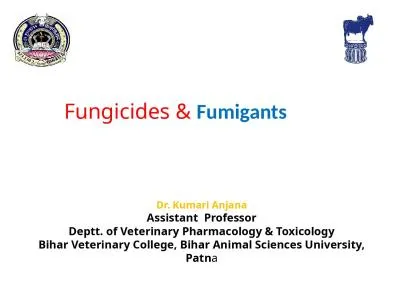

Dr Kumari Anjana Assistant Professor Deptt of Veterinary Pharmacology amp Toxicology Bihar Veterinary College Bihar Animal Sciences University Patn a Content of the chapter Introduction ID: 914055
Download Presentation The PPT/PDF document "Fungicides & Fumigants" is the property of its rightful owner. Permission is granted to download and print the materials on this web site for personal, non-commercial use only, and to display it on your personal computer provided you do not modify the materials and that you retain all copyright notices contained in the materials. By downloading content from our website, you accept the terms of this agreement.
Slide1
Fungicides & Fumigants
Dr.
Kumari
Anjana
Assistant Professor
Deptt
. of Veterinary Pharmacology & Toxicology
Bihar Veterinary College, Bihar Animal Sciences University, Patn
a
Slide2Content of the chapter IntroductionClassificationMechanism of actionClinical signsDiagnosis
Treatment
Slide3FungicidesThese are agrochemicals used to prevent or control fungal infestation of grains, seeds, fruits, vegetables, orchard plants or field crops. Fungicides are classified as; inorganic and organic fungicides.
Slide4Inorganic FungicidesSulphur: Its toxicity is due to its oxidation compounds (sulphur dioxide, sulphur trioxide and thiosulfuric acid) or formation of hydrogen sulphide. Its toxicity is also due to its cross linking of proteins or through formation of free radicals. Sulphur is toxic to cattle, horse and poultry.
The signs of toxicity include colic, gastroenteritis and diarrhoea. Treatment of toxicity is symptomatic.Bordeaux mixture (copper sulphate + calcium hydroxide).
Cadmium chloride:
Slide5Organic fungicidesOrganomercury compounds: Phenylmercury chloride and phenylmercury acetate
Chlorophenols: Pentachlorophenol (PCP): it is fungicide, molluscicide
, insecticide, herbicide and wood preservative. Their toxicity is due to uncoupling of oxidative phosphorylation.
Dithiocarbamates
:
Ziram
,
febam
, zineb,
maneb
,
thiram
etc:
Cause GI disturbances and nervous toxicity.
Phthalimides
:
Captan
,
flopet
and
captofol
:
More toxic to ruminants than other animals;
cause dyspnoea, ascites, hydrothorax and gastroenteritis.
Slide6FumigantsThese are used as grain protectants against insets in the form of fumigation (gaseous) and also to kill the rodents (as baits like rodenticides). The fumigants are either easily volatile liquids or solids capable of liberating gases. Fumigants are used in closed rooms or chambers or containers. These as insecticides, being in gaseous form, are also effective against insects in the burrows (like bed bugs) not usually accessible to conventional pesticides.
Slide7Inorganic FumigantsAluminium phosphide: Exerts action though liberation of phosphine gas like zinc phosphide; causes respiratory tract irritation in animals.
Hydrogen cyanide (HCN): Toxicity due to cyanide.Carbon disulfide (CS2): Interferes with axon function by forming cross linking between
neurofilaments.Its inhalation causes pulmonary oedema, respiratory distress, convulsions, coma and death.
Sulphur dioxide (SO2):
It causes respiratory toxicity.
Slide8Organic FumigantsChloropicrin: It has very strong chlorine smell. Its inhalation causes coughing and respiratory distress. Irritant to eyes and also causing nausea and vomition.
Methyl bromide: Insecticidal fumigant also used in fire extinguishers. It causes neurotoxicity by inactivating –SH enzymes; Its inhalation causes respiratory distress.
Slide9Ethylene dibromide:A soil fumigant; used to control soil worms. Inhalation causes pulmonary distress.Dibromochloropropane (DBCP): It is a nematocidal fungicide fumigant.
Its inhalation caused CNS depression and pulmonary oedema, and sterility in man (occupational exposure) as evident from low sperm counts.
Slide10Thank You